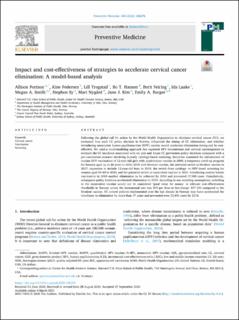| dc.description.abstract | Following the global call for action by the World Health Organization to eliminate cervical cancer (CC), we evaluated how each CC policy decision in Norway influenced the timing of CC elimination, and whether introducing nonavalent human papillomavirus (HPV) vaccine would accelerate elimination timing and be cost-effective. We used a multi-modeling approach that captured HPV transmission and cervical carcinogenesis to estimate the CC incidence associated with six past and future CC prevention policy decisions compared with a pre-vaccination scenario involving 3-yearly cytology-based screening. Scenarios examined the introduction of routine HPV vaccination of 12-year-old girls with quadrivalent vaccine in 2009, a temporary catch-up program for females aged up to 26 years in 2016–2018 with bivalent vaccine, the universal switch to bivalent vaccine in 2017, expansion to include 12-year-old boys in 2018, the switch from cytology- to HPV-based screening for women aged 34–69 in 2020, and the potential switch to nonavalent vaccine in 2021. Introducing routine female vaccination in 2009 enabled elimination to be achieved by 2056 and prevented 17,300 cases. Cumulatively, subsequent policy decisions accelerated elimination to 2039. According to our modeling assumptions, switching to the nonavalent vaccine would not be considered ‘good value for money’ at relevant cost-effectiveness thresholds in Norway unless the incremental cost was $19 per dose or less (range: $17–24) compared to the bivalent vaccine. CC control policies implemented over the last decade in Norway may have accelerated the timeframe to elimination by more than 17 years and prevented over 23,800 cases by 2110. | |
